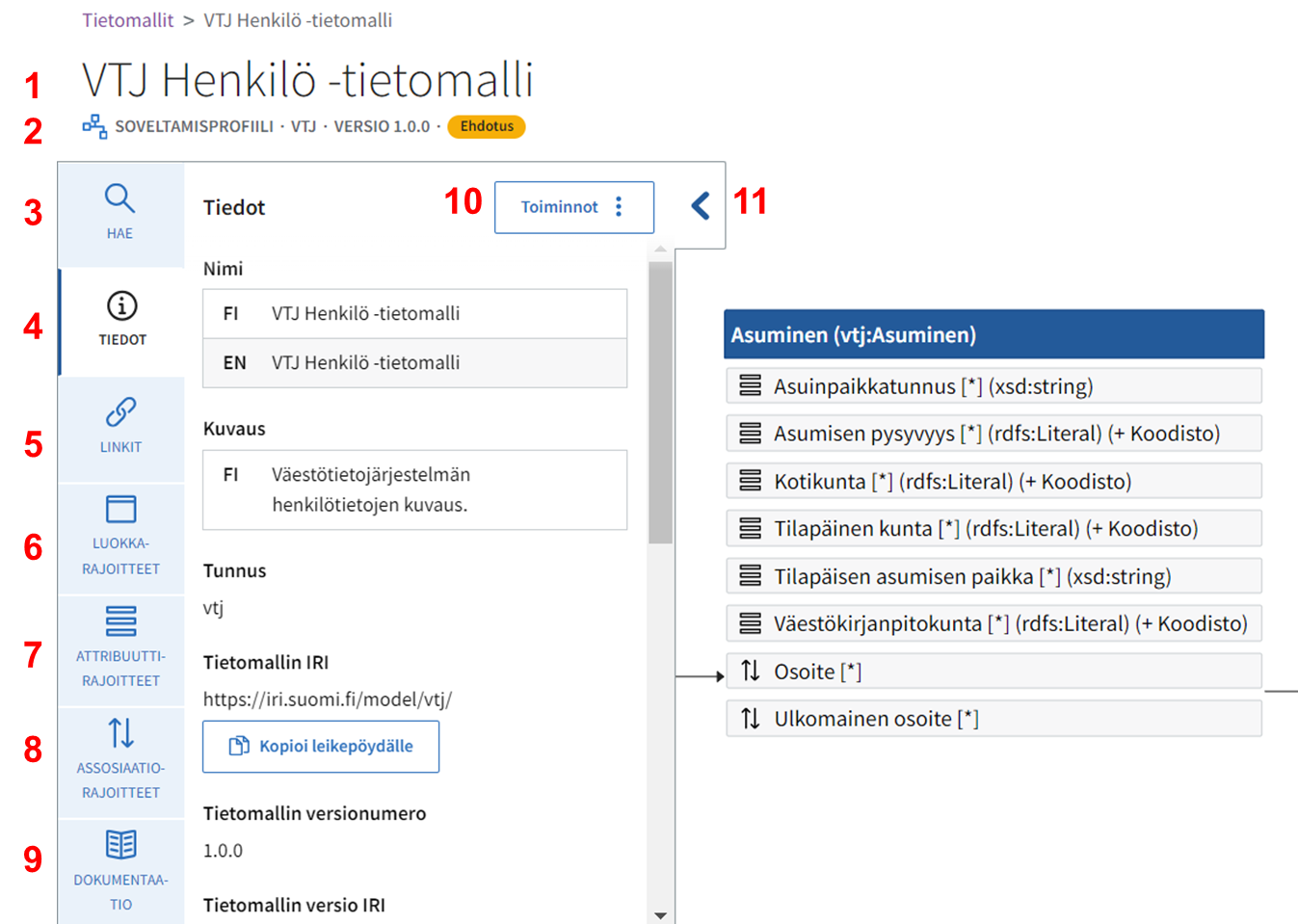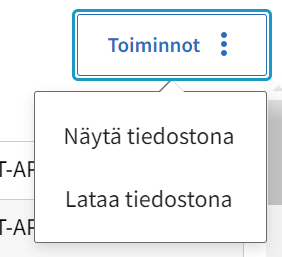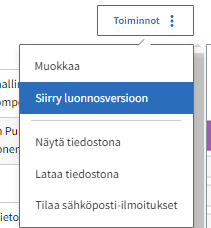Basic information on the data model (1 and 2)
When you open the front page of the data model, you can see the name (1) of the data model and its basic information (2) at the top of the page:
- type of data model: icon and the type of data model (data vocabulary or application profile)
- prefix: the so-called short identifier, unique for every data model in this Tool.
- release version number (if the model has been published)
- status of the data model
- the status can be Suggestion and Valid if the model is published.
- the status can be Draft if the model is still under development; the data model with this status can only be seen by the logged-in members of the contributor organisation. The data model with Draft-status does not have a version number.
More specific information on the data model and its contents can be found from their own subpages (3-9).
On the right side of the data panel, you can see the visualisation (11) of the data model. You can close and open it again from the chevron mark. Further information about the visualisation can be found from its own page.
On the left side of the page, you can find the side panel. By clicking the tabs, you can open and view information on the data model and its resources.
Search for the resources in the data model (class, attribute and association restrictions) (3)
In the Search tab you can see the search field and below it lists of all the class, attribute and association restrictions included within the data model.
Filter the list to show only the data you wish to see with various search criteria. Using the name, search the class, attribute or association restrictions that are included in the data model.
The search results include the resources that match to the search criteria. Click the title to open the class, attribute or association restriction of your choosing.
Information on the data model (4)
In the Details tab you can find the name and description of the data model in all the languages in which the data model has been described. Other information on the tab is, for example, the prefix (short identification), IRI address (long identification), responsible organisation (contributor), information domain(s), creation date, and the date it was last updated. Further information on the data model can be found on an own subpage.
The data models links to terminologies, code lists and other data models (5)
In the Links tab you can find the lists of the terminologies, code lists and other data models which have been utilised in the modelling of the data. For example, a resource may have been linked to a concept in a terminology. A code list with the accepted attribute values can be linked to the attribute restrictions. Further information on the links can be found on their own subpage.
Class restrictions of the data model (6)
In the Class restrictions tab, you can find the list of the class restrictions which are included in the data model, in alphabetical order by name. Click the title of the class restriction from the list to open more specific information of the chosen class restriction. Further information on the class restrictions can be found on their own subpage.
Attribute restrictions of the data model (7)
In the Attribute restrictions tab, you can find the list of the attribute restrictions which are included in the data model, in alphabetical order by name. Click the title of the attribute restriction from the list to open more specific information on the chosen attribute restriction. Further information on the attribute restrictions can be found on their own subpage.
Association restrictions of the data model (8)
In the Association restrictions tab you can find the list of the association restrictions which are included in the data model, in alphabetical order by name. Click the title of the association restriction from the list to open more specific information of the chosen association restriction. Further information of the association restrictions can be found on an own subpage.
Other documentation (9)
The basic information on the data model is given in the Description field, which is under the Documentation tab. In the Documentation tab, you can add longer descriptions and link other complementary documents to the model.
Instructions for adding information to the Documentation page is described on their own subpage.
Actions menu, technical formats (10)
Choose from the Actions drop-down menu alternative Show as file if you want to see the data model on the www-page in the technical format, i.e. serialisation of your choosing.
Choose Download as file if you want to download the file to your computer in the file format of your choosing.
The technical formats you can choose from are JSON-LD, RDF and Turtle.
Hiding and re-opening the visualisation (11)
Click the chevron if you want to hide the left side panel, so that only the data model is shown as a visualisation. By clicking the chevron mark again, you can reopen the panel.
Further information on the contents and functions of the visualisation can be found on their own subpage.
Functions for the user logged in and for the modeller
The user logged-in to the Data Vocabulary Tool can see more functions in the Action menu.
| Function | Description |
|---|---|
| Edit | For the user with modeller access rights: The data model will unlock to editing mode and you can start editing it. |
| Move to the draft | The published data model (statuses Suggested or Valid) cannot be edited, but if you want to make changes and you have the editing rights, you can move to the draft version of the data model. This is a shortcut from a published version to the modifiable draft of the data model. |
| Show as a file | The data model will be shown in the www-page in the technical format of your choosing. |
| Download as a file | The data model will be downloaded to your computer in the file format of your choosing. |
| Order email notifications | The user can order automatic email notifications if a new version is made of a specific data model. The notifications can also be cancelled with this function. |


